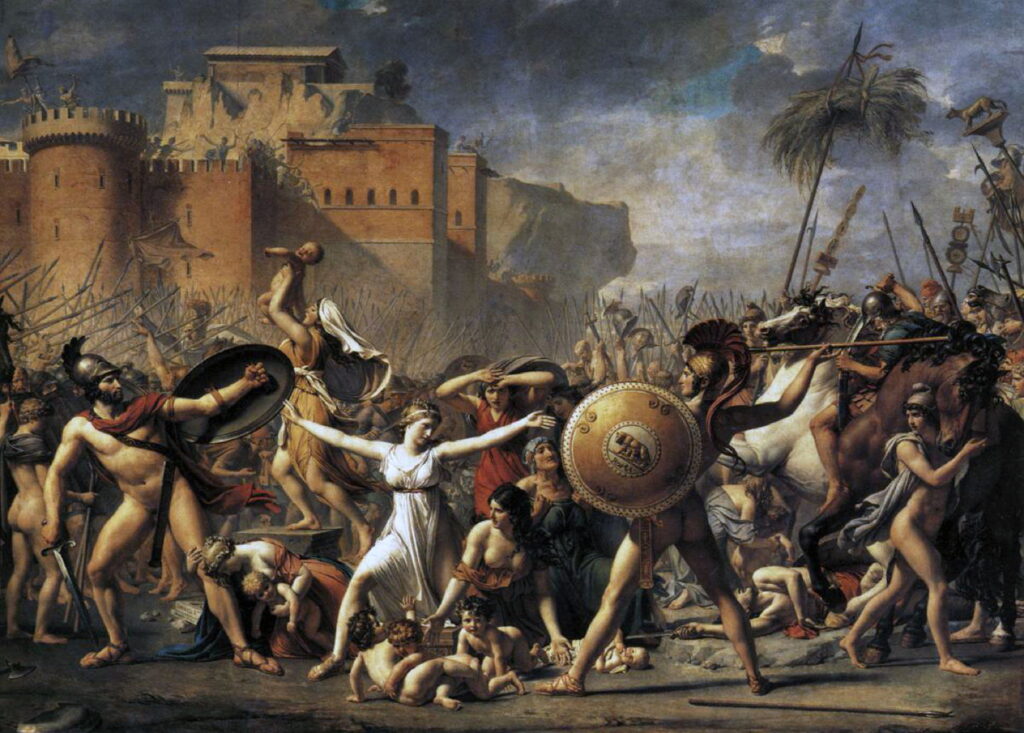Changing Paintings: 70 Romulus and the founding of Rome

After the delightful tale of Vertumnus and Pomona, King Proca dies, and Ovid’s narrative rushes through the founding of Rome by Romulus, so bringing Book 14 of his Metamorphoses to a close.
Ovid tells us that the walls of the city of Rome were founded on the feast day of Pales, 21 April.
Annibale Carracci (1560–1609), Romulus Traces the Boundaries of Rome (1589-92), fresco, dimensions not known, Palazzo Magnani, Bologna, Italy. Wikimedia Commons.
Romulus yoked a plough with a bronze ploughshare to a bull and a cow, and drove a deep furrow around the city’s boundary. This is shown in Annibale Carracci’s fresco in the Palazzo Magnani of Romulus Traces the Boundaries of Rome (1589-92). The bronze ploughshare is at the left, being fixed to a wheeled plough, with Romulus at the right, ready to lead the bull and cow around the boundary.
Next Ovid mentions war with the Sabines led by Tatius, and the Vestal Virgin Tarpeia’s infamous betrayal of the citadel itself. The intruders entered through a gate unlocked by Juno, which Venus couldn’t secure because gods aren’t allowed to undo what other gods have done.
Naiads living next to the shrine of Janus tried to block the intrusion by flooding their spring, but the torrent of water sent down to the open gate didn’t help. So they put sulphur under the spring, and turned it into a river of smoking, molten tar, holding the intruders back until Romulus was able to attack. After a bloody battle, the Romans and Sabines agreed peace, but their king Tatius died (in a riot at Lavinium) and Romulus thus came to rule over both peoples.
Even in Ovid’s time, war with the Sabines and the rape of the Sabine women were controversial, and not a subject that his Metamorphoses dwelt on.
Jacques-Louis David (1748–1825), The Intervention of the Sabine Women (1799), oil on canvas, 385 x 522 cm, Musée du Louvre, Paris. Wikimedia Commons.
Jacques-Louis David’s The Intervention of the Sabine Women (1799) is unusual among depictions of the episode of the Sabine women in showing its resolution, rather than the seizure of the women that brought the conflict about.
After the overwhelmingly male population of the nascent city of Rome had seized the wives and daughters of their neighbours the Sabines, the two groups of men proceeded to fight. David shows Roman and Sabine men joined in battle before the great walls of Rome, with the Sabine women and their children mixed in, trying to restore peace. Looming over the city is the rugged Tarpeian Rock, from which traitors and other enemies of Rome were thrown. Named in dishonour of the treacherous Tarpeia, she wasn’t its first victim: she was crushed to death by the shields of the Sabines she had let into the citadel, and is reputed to have been buried in the rock.
Highlighted in her brilliant white robes in the foreground, and separating two of the warriors, is the daughter of the Sabine king Tatius, Hersilia, whom Romulus married. The warriors are, of course, her father and her husband, and the infants strategically placed by a nurse between the men are the children of Romulus.
David started this painting when he was imprisoned following his involvement in the French Revolution. He intended it to honour his estranged wife, who had continued to visit him during his incarceration, and to make the case for reconciliation as the resolution of conflict.
Guercino (1591–1666), Hersilia Separating Romulus and Tatius (1645), oil on canvas, 253 x 267 cm, Musée du Louvre, Paris. Wikimedia Commons.
Guercino’s Hersilia Separating Romulus and Tatius (1645) concentrates on the three figures of Tatius, Hersilia, and Romulus, and tucks the rest of the battle away in the distance behind them.
The time came for Romulus to hand on the new Roman state to his successor; Mars therefore called a council of the gods, and proposed that the founder of Rome should be transformed into a god, which Jupiter approved. With that Mars descended to the Palatine hill in Rome, where he found Romulus laying down laws for the city. The body of Romulus dissolved into thin air and he was carried up to the heavens to become the Roman god Quirinus.
Jean-Baptiste Nattier (1678–1726), Romulus being taken up to Olympus by Mars (c 1700), oil on canvas, 99 × 96.5 cm, Muzeum Kolekcji im. Jana Pawła II, Warsaw, Poland. Wikimedia Commons.
Only Jean-Baptiste Nattier painted the apotheosis of the founder of Rome, in his Romulus being taken up to Olympus by Mars from about 1700. Mars is embracing Romulus, with the standard of Rome being borne at the lower left, and the divine chariot ready to take Romulus up to the upper right corner, where the rest of the gods await him.
When his queen Hersilia mourned the loss of Romulus, Juno sent Iris to invite her to join her husband. Hersilia then rose with a star to become the goddess Hora. This sets the stage for the opening of the fifteenth and final book of Ovid’s Metamorphoses.



